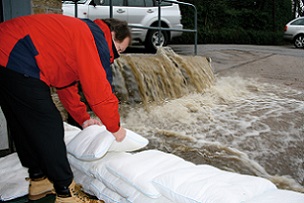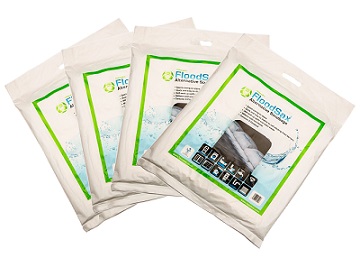 Flooding can cause terrible trauma and stress
Flooding can cause terrible trauma and stress
 FloodSax alternative sandbags can hold back a torrent of floodwater
FloodSax alternative sandbags can hold back a torrent of floodwater
 FloodSax sandless sandbags come in easy-to-carry bags which are space-saving to store
FloodSax sandless sandbags come in easy-to-carry bags which are space-saving to store
10 reasons why you MUST protect your home or business from flooding … inside and out
Flooding is an absolute nightmare in every sense of the word and is one of the most traumatic experiences anyone can suffer.
Yet it can so often be avoided.
Here are 10 reasons why everyone must protect their homes or businesses from flooding. Investing a few hundred pounds (or even less) before a flood can save you tens of thousands of pounds damage afterwards.
And that’s only the start as floods are known to cause long-lasting anxiety and other mental health problems for victims whose lives are turned upside down, often forced to live in caravans, rented accommodation or with relatives for months, if not years, while repair work is carried out.
So here are 10 reasons why it’s vital everyone is prepared to stop floodwater getting in from the outside or soaking up drips, leaks, spills and floods inside – 10 reasons to avoid the awful trauma of being flooded.
- Councils have absolutely no responsibility to provide sandbags or any other flood mitigation products if flooding is imminent. The Environment Agency says: “Don’t assume the authorities will provide you with sandbags in a flood emergency. It’s the responsibility of property owners to take appropriate action to protect their property from flooding.”
- Sandbags don’t work anyway. The Environment Agency adds: “Sandbags are relatively ineffective when compared to purpose-built flood protection products. We strongly encourage people to use these products.”
- Many home and business insurance policies charge high excesses for flooding often running into several hundreds of pounds, far higher than for other claims.
- The cost of materials to repair flood damage is forever going up – everything from timber to tiles.
- Shortage of supply is a real problem with some products still not available since manufacturing was massively scaled back during covid which means repairs to your home or business after flooding may be severely delayed.
- Waiting for contractors to do the work. Good tradesmen are usually always busy with work lined up for months so you may have to wait ages for the repair work to even start or put up with work that’s not done as well.
- Flooding is known to have a severe impact on people’s mental health and you can read more about that here.
- Flooding causes colossal damage as the water destroys everything it touches. It’s known as “the thief who takes everything” as insurance claims after flooding are usually around 37 times higher than for a burglary. That’s just over £30,000.
- Sadly, many businesses never reopen once they have been closed due to a flood as it takes so long to get back in action customers have gone elsewhere.
- Peace of mind is all-important and a sense of security knowing you are protected from flooding 24 hours a day, seven days a week and 365 days a year.
Flooding can be prevented by using temporary flood barriers such as award-winning FloodSax alternative sandbags which were invented in Yorkshire, a county that sees more than its fair share of rain each year.
They are space-saving to store yet quick and easy to deploy. In their dry state they are flat and exceptionally thin with a large surface area so are ideal to soak up leaks, spills, drips and floods inside homes and businesses such as beneath pipes or under kitchen cupboards and radiators.
To transform them into instant alternative ‘sandless’ sandbags simply immerse them in water and in around 5 minutes they will expand to weigh around 20kg. Their uniform shape means they can be built into effective flood barriers.
Around 3 million FloodSax have been sold worldwide since 2007.
For more information go to http://www.floodsax.co.uk/